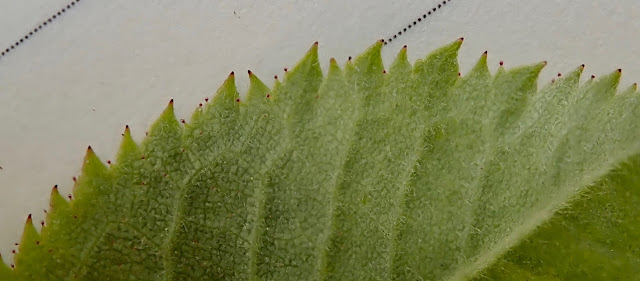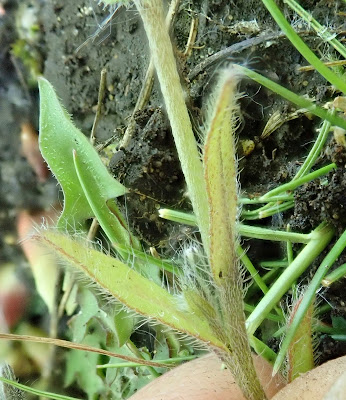Acicles, Prickles and Stalked glands in Wild Roses. Photos and thoughts.
 |
| Rosa rubiginosa showing pedicle acicles and stalked glandular hairs. |
Since June I have been looking at Roses. A difficult group of species which often hybridise.
 |
| P. pimpinellifolia All prickles or are there acicles as well? |
Another definition from CTW is :- Very slender prickles or stiff bristles, not stout-based, sometimes gland-tipped. Stace defines acicle as - a slender prickle with scarcely widened base.
In practice these definitions hide the fact that stalked-glandular hairs, acicles and straight prickles could be said to form a continuum.
Location.
The acicles can be present on the pedicle/hypanthium and the flowering stems although the stem version are hard and stiff whereas the versions on the pedicle are flexible. Maybe separate names could be used for the types of 'hair' found on the pedicle/hypanthium vs stem.
 |
| R. rubiginosa hypanthium and pedicle (flower stem).This photo shows the longer non glandular acicles and the shorter glandular stalked hairs. |
The above photo of R. rubiginosa clearly shows two types of hair.
Glandular hair. Some are clearly stalked glandular hairs with the gland being of a size that forms a large ball whose diameter is several times that of the diameter of the hair tip, on which it rests.
Acicle. The second type of 'hair' is generally longer, has a thicker tapering body and usually ends without a glandular tip. I have regarded these as acicles. Occasionally these acicles have glandular tips but these are often not balls but just darkened ends. One feature is that the very base of these acicles is not enlarged by any great extent unlike a prickle.
Since acicles are a feature of R. rubiginosa and are not seen on R. micrantha or the Downy roses like R. sherardii it might be worth looking at examples of pedicle/hypanthium hairs on these species.
 |
| R. sherardii 23rd September, West Cork. |
The point of this photo is to show that no acicles are present which is what you would expect, but that the length of the stalked glandular hairs can include very long ones. Length cannot be used as a determining feature in distinguishing acicles from glandular hairs.
 |
| R. micrantha, 12th June, Cambridge. |
The above photo shows Small-flowered Sweet Briar with stalked glandular hairs and no acicles which conforms to the expected species description. These glandular hairs do not appear insect friendly.
 |
| R. rubiginosa. 14th October , Croydon. |
The glandular tips are deteriorating rapidly turning white at this time when the fruit are going soft. This photo shows how difficult it can be to distinguish between the stalked glandular hairs and the acicles which can be the same length. The lower right 'hair' had a large ball of sticky chemical whereas the one going left looks as if it just terminates in a point and is therefore a acicle. The complication is that glandular hairs can lose their glandular tips and acicles can occasionally have glandular tips with a ball shaped gland on.
 |
| R. rubiginosa 14th Oct Croydon. |
A feature of R. rubiginosa is the unequal prickles on the stems. This photo shows the variation of dense prickles, many of which are thin and narrow pointed and might be regarded as acicles. The more typical curved prickle is shown in the next photo which is part of the same plant. This variation in the shape of the prickles is typical of rubiginosa.
 |
| R. rubiginosa 14th Oct Croydon showing more typical shaped prickles. |
 |
| R. rubiginosa , stem just below pedicles |
The descriptions in the literature do not clearly differentiate between an acicle and a straight thin prickle. I would regard the prickles on the main stem as thin prickles since they have a elliptical base. Strangely some have a tiny glandular tip. This is an example of the intermediate characteristics that occur. The conflict in the description about the base being either wide or not wide, from the Rose handbook, CWT and Stace, adds to the confusion. My thought is that it's the shape of the base rather than the width, that to me seems to separate prickles from acicles.
 |
| 14th Oct Hybrid R. micrantha/rubiginosa |
The above photo shows an acicle with three stalked glandular hairs. The glandular tips are deteriorating at this late stage. All have slightly wider bases but this is limited compared with a true prickle.
 |
| Example of accicle with round base on stem just below pedicles. |
 |
| Stalked glandular hair on hypanthium ( R. tomentosa) |
 |
| Intermediate in that the base appears somewhat elliptical but tiny glandular tips are present. |
 |
| A straight prickle, based on its elliptical base. |
Fig 1. Possible difference between stalked glandular hairs, acicles and narrow straight prickles.
Length is variable although acicles are often longer than stalked glandular hairs on the pedicle/hypthanium. Bases can be smaller than shown as proportions are for short versions.
Glandular hairs sometimes lack the glandular tip and acicles occasionally have glandular tips. Surprisingly even straight prickles have been seen with glandular tips on one occasion so all three types are not absolute in their features. Approximate colouring is late season, hairs and acicles are green at flowering time. Prickles are rigid when mature, acicles and stalked glandular hairs remain flexible on the pedicle. Acicles have a tapering tip, sometimes darker or occasionally a glandular ball which might be slightly smaller than usually seen on adjacent stalked glandular hairs. Since no absolute difference is 100%, check more candidates on the plant to determine the presence of acicles.
With roses, no rule is 100%, so careful consideration has to be given to the complete range of features.
I have avoided using the term 'pricklet' as in the handbook it is used to describe the smaller prickles that occur on the petiole and rachis ( leaf stems).
 |
| Pricklet on rachis |
Another term used is bristle, which is used in place of acicle in Harrap's wild flowers.
Peter Leonard Rampton 18th October 2020
Please comment if you can add anything to this possible interpretation or let me know if I have misunderstood the literature. The rose season is just about over so it will be next year before I can learn more about this difficult group.
Reference:- Roses of Great Britain and Ireland by G.G. Graham and A.L. Primvesi, BSBI Handbook No 7.










































































